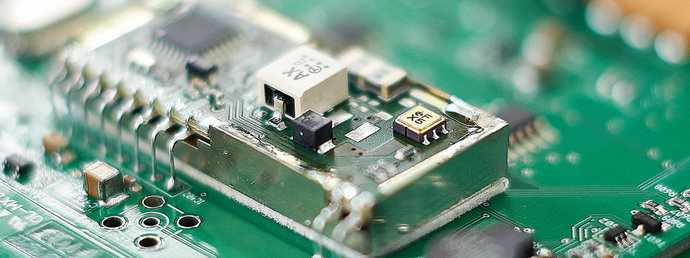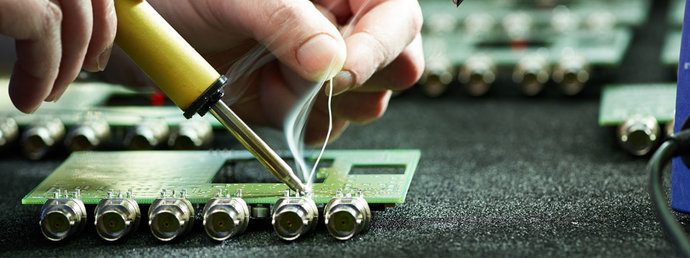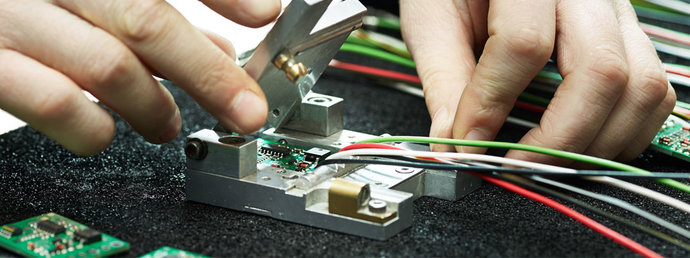Change of name: ESO Electronic Service Ottenbreit GmbH has changed its name to Newmatik GmbH.
You can find more information about our move and our change of name here.
Automotive. Oil & Mining. LED technology. Aviation. Public Safety. Medical.
These are just some of the industries for which we produce electronics.
ESO Electronic is your partner for electronic manufacturing services. With locations in Germany, Romania, and the United States, we provide development and prototyping, SMT & THT assembly, cable & device assembly, materials management, and logistics in a streamlined supply chain. From ideation to assembly to delivery, we pride ourselves on providing customized, full-service offerings to our clients.
Whether it is a prototype of a new intelligent automotive braking system that ensures you arrive safely at your destination, or a series production of high-definition cameras that capture your favorite team's big game, we make products that matter. Through our absolute commitment to customer service and uncompromising quality, we exceed our clients' expectations by creating innovative solutions.
ESO Electronic Service Ottenbreit GmbH is an electronics manufacturing service provider (EMS). We specialize in SMT and conventional THT assembly of electronic boards. In addition, we also offer electronic design and development services, as well as SMT and BGA rework. We see ourselves not just as providers of electronics manufacturing services, but rather as a trusted partner ready to assist our clients during the design and development phases. When mistakes are made with projects produced elsewhere, we are also there to support our clients with SMT and BGA rework services. Our range of services – from the initial design stages through SMT or THT assembly, to rework and logistics – enables us to provide a true package of value to our customers.
SMT Assembly
The first step of the electronics manufacturing process is usually SMT assembly (surface mounted device). During this SMT assembly, SMT components are placed on the PCB using soldering paste that is applied to the board with a stainless steel stencil. After this step is completed, the SMT components are placed on the electronic boards with a fully automated machine. We use SMT assembly machines from Mydata, which enables us not only to produce cost-effective prototypes and small series orders, but also medium-series production batches. SMT components are delivered to us from our distributors in standard packaging, which is then prepared for assembly by loading it into magazines from which the assembly arm takes components to be placed on the PCB. At the end, a final visual inspection of the soldered SMT components is performed to make sure that each piece was correctly placed on the soldering paste before the boards are moved forward in the assembly line to the reflow station, where they are heated to 260°C and soldered. Once the tin solder is heated to this temperature, the SMT components are now permanently affixed to the board. We use various solder pastes depending on the customer's requirements and the needs of the components themselves. After the Reflow process, the assembled electronic boards are checked with an automated optical inspection (AOI). The AOI inspection automatically checks that the solder paste has been correctly applied at the precise places on the electronic boards. The results of the AOI quality inspection are then reviewed by a member of our highly trained production team.
If you would like to learn more about the SMT production process, we recommend our EMS Knowledge Base Article "How does SMT electronics assembly work?"
Conventional Assembly (THT assembly)
As an EMS provider, we specialize not only in SMT assembly, but also in conventional (THT) assembly for prototypes, small- and medium series orders. Assembly of wire-leaded THT components is typically performed in addition to the SMT process. For this reason, many boards require the so-called "mixed assembly" using both SMT and THT assembly methods. In through-hole (THT) assembly, the components are placed on the board by hand. Instead of the soldering paste and reflow steps of SMT, THT components are applied using various methods. Depending on the kind of component, either wave soldering or conventional soldering is performed to connect the THT components to the pads using tin solder. As with SMT assembly, visual inspections are carried out during the THT process to confirm that the boards have been correctly assembled.
If you would like to learn more about the THT production process, we recommend our EMS Knowledge Base Article "How does conventional THT assembly work?"
Quality
Our in-house quality checks during the production process are specified by our customers according to their required quality standards, ranging from visual inspections to automated AOI inspections. Quality inspections check whether the SMT or THT components have been correctly assembled before the boards are released for delivery. When the quality check confirms that everything is right, the boards are now ready for delivery.
If you would like to learn more about our quality processes and standards according to DIN EN ISO 9001, we recommend our article on quality.















